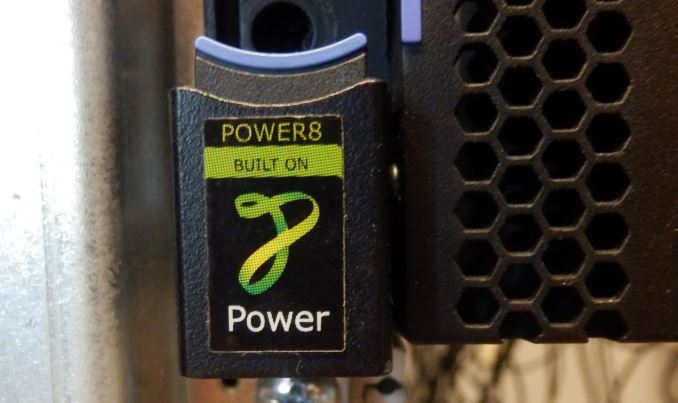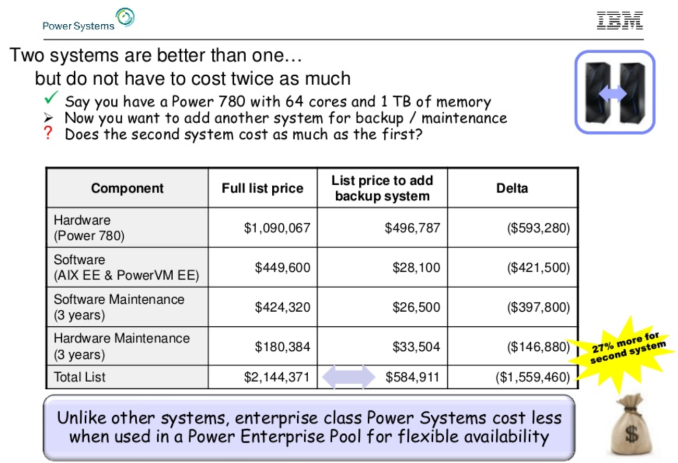The IBM POWER8 Review: Challenging the Intel Xeon
by Johan De Gelas on November 6, 2015 8:00 AM EST- Posted in
- IT Computing
- CPUs
- Enterprise
- Enterprise CPUs
- IBM
- POWER
- POWER8

Five years. That is how much time has passed since we have seen an affordable server processor that could keep up with or even beat Intel's best Xeons. These days no less than 95% of the server CPUs shipped are Intel Xeons. A few years ago, it looked like ARM servers were going to shake up the market this year, but to cut a long story short, it looks like the IBM POWER8 chip is probably the only viable alternative for the time being.
That was also noticeable in our Xeon E7 review, which was much more popular than we ever hoped. One of the reasons was the inclusion of a few IBM POWER8 benchmarks. We admit that the article was however incomplete: the POWER8 development machine we tested was a virtual machine with only 1 core, 8 threads and 2 GB of RAM, which is not enough to do any thorough server testing.
After seeing the reader interest in POWER8 in that previous article, we decided to investigate the matter further. To that end we met with Franz Bourlet, an enthusiastic technical sales engineer at IBM and he made sure we got access to an IBM S822L server. Thanks to Franz and the good people of Arrow Enterprise Computing Solutions, Arrow was able to lend us an IBM S822L server for our testing.
A Real Alternative?
Some of you may argue that the POWER based servers have been around for years now. But the slide below illustrates what we typically associated IBM's POWER range with:
Proudly, the IBM sales team states that you can save 1.5 million dollars after you have paid them 2 million dollars for your high-end 780 system. There is definitely a market for such hugely expensive and robust server systems as high end RISC machines are good for about 50,000 clients. But frankly for most of us, those systems are nothing more than an expensive curiosity.
Availability can be handled by software and most of us are looking/forced to reduce our capital expenses rather than increase them. We want fast, "reliable enough" servers at low costs that are easy to service. And that is exactly the reason why the single and dual sockets Xeon servers have been so popular the past decade. Can an IBM POWER server be a real alternative to the typical Xeon E5 server? The short but vague answer: a lot has changed in the past years and months. So yes, maybe.











146 Comments
View All Comments
psychobriggsy - Friday, November 6, 2015 - link
So you are complaining that your job's selection of hardware has made you earn twice as much?dgingeri - Friday, November 6, 2015 - link
No, because I don't earn twice as much. I'm not fully trained in AIX, so I have to muddle my way through dealing with the test machines we have. We don't use them for full production machines, just for testing software for our customers. (Which means I have to reinstall the OS on at least one of those machines about every month or so. That is a BIG pain in the behind due to the boot procedure. Where it takes a couple hours to reinstall Windows or Linux, it takes a full day to do it on an AIX machine.)I'm trying to advise people to NOT use AIX. It's an awful operating system. I'm also advising people NOT use IBM Power based machines because they are extremely aggravating to work on. Overall, it costs much more to run IBM Power machines, even if they aren't running AIX, than it does to run x86 machines. The up front cost might look competitive, but the maintenance costs are huge. Running AIX on them makes it an order of magnitude more expensive.
serpint - Friday, November 6, 2015 - link
I suggest reading the NIM A-Z handbook. It shouldn't take you more than 10 minutes to fully deploy an AIX system fully built and installed with software. As with Linux, it also shouldn't take more than about 10 minutes to install and fully deploy a server if you have any experience scripting installs.The developerworks community inside IBM is possibly the best free resource you could hope for. Also the redbooks.ibm.com site.
Compared to most *NIX flavors, AIX is UNIX for dummies.
agtcovert - Tuesday, November 10, 2015 - link
If you had a NIM server setup and were using LPARs, loading a functional image of AIX should take 10 minutes flat, on a 1G network.If you're loading AIX on a physical machine without using the virtualization, you're wasting the server.
agtcovert - Tuesday, November 10, 2015 - link
I've worked on AIX platforms extensively for about the same amount of time. First, most of these purchases go through a partner and yours must've sucked because we got great support from our IBM partner -- free training, access to experts, that sort of thing.Second, I always love the complaining about the cost of the hardware, etc. If you're buying big iron Power servers, the maintenance cost should be near irrelevant. And again, your partner should take care to negotiate that into the deal for 3-5 years ensuring you have access to updates.
The other thing no one ever talks about is *why* you buy these servers. Why do they take so long to boot? Well, for the frame it self, it's a deep POST. But then, mine were never rebooted in 4 years, and that's for firmware upgrades (online) and a couple of interface card swaps (also done online with no service disruption). Do that on x86. So reason #1 -- RAS, at the hardware level. Seriously, how often did you need to reboot the frame?
Reason #2 -- for large enterprises, you can do so much with these with relatively few cores they lead to huge licensing savings in Oracle, IBM software. For us, it was over $1m a year ongoing. And no, switching to other software was not an option. We could run an Oracle RAC on 4 cores of Power 7 (at the time) versus the 32 x86 it was on previously. That saves a lot of $.
The machine reviewed does not run AIX. It's Linux only. So the maintenance, etc. you mention isn't even relevant.
There are still things that are annoying I suppose. AIX is steeped in legacy to some degree, and certainly not as easy to manage as a Linux box. But there are a lot of guides out there for free -- it took me about a month to be fully productive. And the support costs you pay for -- well, if I ran into a wall, I just opened a PMR. IBM was always helpful
nils_ - Wednesday, November 11, 2015 - link
I'm mostly working in Linux Devops now, but I remember dreading to use all the "classic" Unix machines at my first "real" job 12 years ago. We ran a few IRIX and AIX boxes which were ancient along itself. Hell even the first thing I did on my work Macbook was to replace the BSD userland with GNU wherever possible.It's hard to find any information on them and any learning materials are expensive and usually on dead trees. They pretty much want to sell training, consulting etc. along with the often non-competitive Hardware prices since these companies don't actually WANT to sell hardware. They want to sell everything that surrounds it.
retrospooty - Friday, November 6, 2015 - link
The problem with server chips is that its about platform stability. IBM (and others) dropped off the face of the Earth and as mentioned above Intel now has 95% of the market. This chip looks great but will companies buy into it in mass? What if IBM makes another choice to drop off the face of the Earth again and your platform is dead ended? I would have to think long and hard about going with them at this point.FunBunny2 - Friday, November 6, 2015 - link
Not likely. the mainframe z machines are built using POWER blocks.Kevin G - Friday, November 6, 2015 - link
POWER and System Z are two different architectures. Case in point, POWER is a RISC design introduced in the 90's where as the System Z mainframes can trace their roots to a CISC design from the 1960's (and it is still possible to run some of that 1960's code unmodified).They do share a handful of common parts (think the CDIMMs) to cut down on support costs.
plonk420 - Friday, November 6, 2015 - link
can you run an x264 benchmark on it?? x)